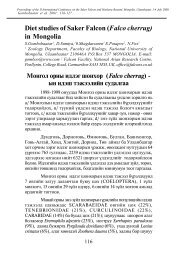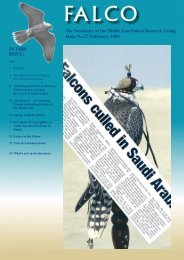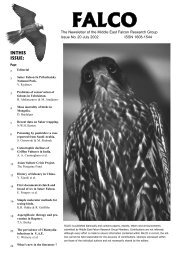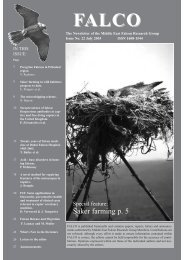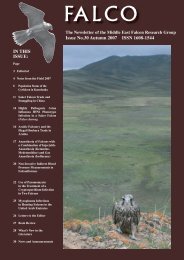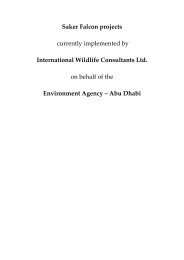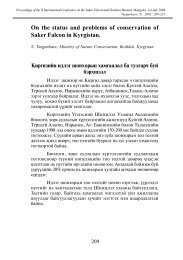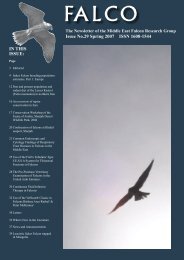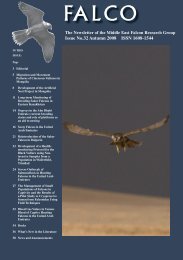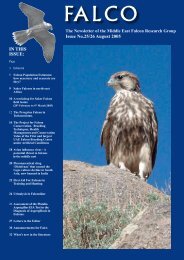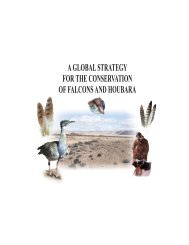Falco cherrug - International Wildlife Consultants Ltd.
Falco cherrug - International Wildlife Consultants Ltd.
Falco cherrug - International Wildlife Consultants Ltd.
You also want an ePaper? Increase the reach of your titles
YUMPU automatically turns print PDFs into web optimized ePapers that Google loves.
forests, as it will become the reservoir bed. The total area of<br />
forest clear-cuts, as estimated by the Landsat7 imagery and<br />
GIS processing was 18.04 km 2 . The valley slopes had been<br />
cleared up to 60 m above the riverbed, both sides have new<br />
roads carved in for heavy construction vehicles. As a result<br />
a total of 20 breeding territories of Peregrines have ceased<br />
to exist.<br />
In 1996 breeding occurred in 18 out of 20 pairs<br />
(only two pairs did not breed due to disturbance caused by<br />
construction). Breeding by 2 pairs of the remaining 18 was<br />
not successful, but a total of 34 fledglings left the nests of<br />
16 pairs. After construction work 2003 a total of 14 breeding<br />
territories ceased to exist, one new breeding territory<br />
upstream of the reservoir site has been establishe;, and only<br />
6 pairs were breeding on their old territories (most of them<br />
in niches). Breeding by 5 pairs has been successful: they<br />
produced 10 fledglings. So the total toll of the construction<br />
is a decrease more than 3 times with a similar reduction in<br />
the breeding rate per total territory.<br />
We noticed that the disappearance of 14 pairs of<br />
Peregrines from the Belaya did not lead to an increase in<br />
the numbers in the upper part of the river. Here only one<br />
new breeding territory was found. We believe that the limiting<br />
factor for Peregrines in the upper Belaya river is a high<br />
density of Eagle Owls (Bubo bubo) as well as a high density<br />
of Peregrines. It appears that the Peregrines uprooted by<br />
the reservoir construction had no place to go nearby.<br />
In 2004 it is planned to fill up the newly constructed<br />
reservoir with water. This undoubtedly means that the<br />
remaining 6 pairs will be flooded. It is possible that after<br />
their the situation will settle. The Peregrines might re-occupy<br />
the cliffs above the newly formed reservoir, but the density<br />
will never be the same. We have indirect evidence in a<br />
similar situation, that has been developed at the Nugush<br />
Water Reservoir, which is located 7 km north of the Belaya<br />
River. We have surveyed old nest sites on the cliffs and<br />
compared this with the numbers after the reservoir had been<br />
filled up. The number of historic sites around the reservoir<br />
were twice as high than the numbers in 1996-98.<br />
25<br />
20<br />
15<br />
10<br />
5<br />
0<br />
1996 2003<br />
Figure 5. Number of Occupied (black columns) territories<br />
and number of breeding pairs before flooding (1996) and<br />
after flooding of the reservoir in 2003.<br />
References<br />
Danilov-Danielyan, V.I. Ed. – in – Chief. 2001. Red Data<br />
Book of the Russian Federation (animals). Ast-<br />
Astrel Publishers. Moscow.<br />
Heath, M., Borggreve, C., Peet, N. and Hagemeijer W. (eds)<br />
2000a. European bird populations: estimates and<br />
trends. – Cambridge, UK: BirdLife <strong>International</strong><br />
(BirdLife Conservation Series 10). – 160 p.<br />
Heath, M.F. and Evans, M.I. (eds) 2000b Important Bird<br />
Areas in Europe: Priority sites for conservation. 2<br />
vols.– Cambridge, UK: BirdLife <strong>International</strong><br />
(BirdLife Conservation Series 8). – 800 p.<br />
Karyakin, I. 1998a. Conspectus of the bird fauna of<br />
Bashkortostan. Perm. Publication of the Ural Union<br />
of the Animal Protection, 253 pp. (In Russian).<br />
Karyakin, I. 1999b. Raptors of the Ural Region.<br />
<strong>Falco</strong>niformes and Strigiformes. Perm. Publication<br />
of the Ural Union of the Animal Protection and<br />
Social-Ecological Union, 253 pp. (In Russian).<br />
Karyakin, I. 2003. Peregrines in the Volga-Ural region. In<br />
press.<br />
Kucherov, E.V. ed.-in-chief. 1987. Red Data of the Bashkiria.<br />
Bashknigizdat publishers. 200 pp.<br />
Sviridova, T. and Zubakin V. 2000. Key ornithological territories<br />
of Russia. V. 1. RBSU. 702 p.<br />
Amyloidosis in Captive <strong>Falco</strong>ns in the United Arab Emirates<br />
Peter McKinney MVB,MRCVS<br />
<strong>Wildlife</strong> Protection Office, PO Box 27962, Dubai, UAE.<br />
Introduction<br />
During the last five years there has been an<br />
increasing number of falcons presented with advanced amyloidosis.<br />
The scale of the problem is difficult to quantify as<br />
there is a massive movement in falcons throughout the<br />
region resulting in a lack of clinical monitoring.<br />
Many chronically ill cases are treated using traditional<br />
medicines and may not be presented to a veterinary<br />
facility. Most falcons that die in the Middle East are not<br />
presented for post-mortem examination. Amyloidosis cases<br />
are usually diagnosed after the moulting season when birds<br />
are presented for a pre-training veterinary examination.<br />
Amyloidosis describes the extracellular deposition<br />
of a protein termed amyloid –AA in various organs as a<br />
result of chronic antigenic stimulation. The primary target<br />
organs in falcons are the liver, spleen and kidneys (Cowan<br />
1968)<br />
Methods<br />
Twenty one advanced amyloid cases submitted to<br />
the Al Safa Clinic were investigated over a three year period.<br />
Site of amyloid deposition<br />
The majority of cases have amyloid deposits in the<br />
liver, spleen and kidney. The spleen and liver can be affected,<br />
but the kidney may be normal (Table 1). <strong>Falco</strong>ns with<br />
renal amyloidosis tend to become ill and die suddenly compared<br />
to falcons where the amyloid is restricted to the liver.<br />
Many cases are found dead in the moulting room. Postmortem<br />
examination often shows pericardial gout with<br />
renal, hepatic and splenic amyloidosis. A period of three to<br />
six months can be sufficient for the development of<br />
advanced amyloidosis. If there is no renal involvement the<br />
falcon tends to live for a longer period.<br />
14



